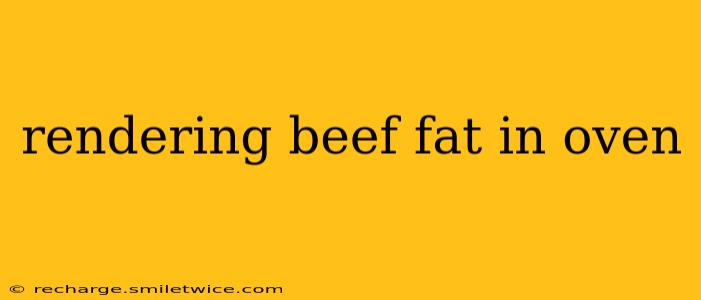Rendering beef fat, also known as tallow, is a rewarding process that yields a versatile cooking fat with a rich flavor. While stovetop rendering is common, oven rendering offers a hands-off approach, perfect for busy cooks. This guide will walk you through the process, answering common questions and providing tips for success.
What is Beef Tallow and Why Render It?
Beef tallow is the rendered fat from beef cattle. It's a saturated fat, prized for its high smoke point (around 420°F or 215°C), making it ideal for high-heat cooking methods like frying and searing. Rendering transforms raw fat into a usable, stable fat that lasts much longer than raw fat. It removes impurities and water, resulting in a pure, refined product. Many appreciate its rich flavor, adding depth to dishes.
How to Render Beef Fat in the Oven: A Step-by-Step Guide
What You'll Need:
- 2-3 pounds of beef fat (suet, kidney fat, or a mix works well) – You can often obtain this from your butcher.
- A large roasting pan
- Aluminum foil or parchment paper (optional, for easier cleanup)
- A fine-mesh sieve or cheesecloth
- Heat-resistant container for storing rendered tallow
Instructions:
- Preheat your oven to 300°F (150°C).
- Prepare the roasting pan: Line the pan with aluminum foil or parchment paper for easy cleanup.
- Chop the fat: Cut the beef fat into roughly 1-inch cubes. Smaller pieces render faster, but larger ones are fine too.
- Spread the fat: Arrange the fat cubes in a single layer in the roasting pan. Avoid overcrowding.
- Roast: Roast for 2-3 hours, or until the fat is golden brown and crispy, and the rendered tallow is clear and liquid. Stir occasionally to ensure even rendering. You'll know it's done when the cracklings (crispy bits) are golden brown and easily crumbled.
- Strain the tallow: Carefully remove the pan from the oven (it will be hot!). Let it cool slightly before straining. Pour the contents through a fine-mesh sieve or cheesecloth lined strainer into your storage container. This removes any remaining cracklings or impurities.
- Cool and store: Allow the tallow to cool completely before sealing and storing in the refrigerator or a cool, dark place. It will solidify as it cools. Rendered tallow can last for months, even up to a year, if stored properly.
How Long Does it Take to Render Beef Fat in the Oven?
Rendering time depends on the amount of fat, the size of the pieces, and your oven's temperature. Expect it to take anywhere from 2 to 4 hours. Check on it periodically; if it seems to be taking longer, you may need to increase the oven temperature slightly (by 25°F), but be cautious not to burn it.
What Temperature Should I Render Beef Fat in the Oven at?
The ideal temperature is 300°F (150°C). A lower temperature will render the fat more slowly but minimizes the risk of burning. Higher temperatures might cause the fat to brown too quickly before rendering is complete.
Can I Use Other Cuts of Beef Fat for Rendering?
Yes, you can use various cuts of beef fat for rendering, including suet (found around the kidneys), kidney fat, and even the fat trimmings from other cuts of beef. Each will have a slightly different flavor profile.
What Can I Do With Rendered Beef Tallow?
Rendered beef tallow is incredibly versatile. Use it for:
- Frying: Its high smoke point makes it excellent for frying potatoes, eggs, or other foods.
- Baking: Add it to pie crusts, cookies, or other baked goods for a richer flavor and flakiness.
- Searing: Sear meats for delicious browning and a crispy crust.
- Soap making: Tallow is a traditional ingredient in homemade soaps.
- Lubrication: Historically, tallow has been used as a lubricant for various applications.
Conclusion
Rendering beef fat at home is a simple yet rewarding process. The result is a versatile cooking fat with a rich flavor and long shelf life. With this guide, you can easily create your own high-quality tallow and enjoy its many benefits in your kitchen. Remember to always practice safe food handling techniques and ensure your oven is properly ventilated.
